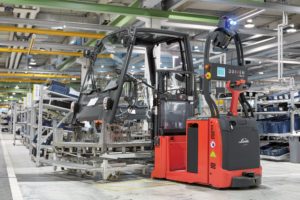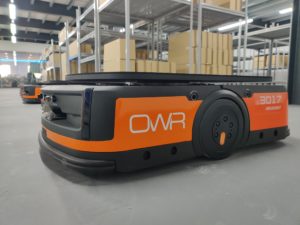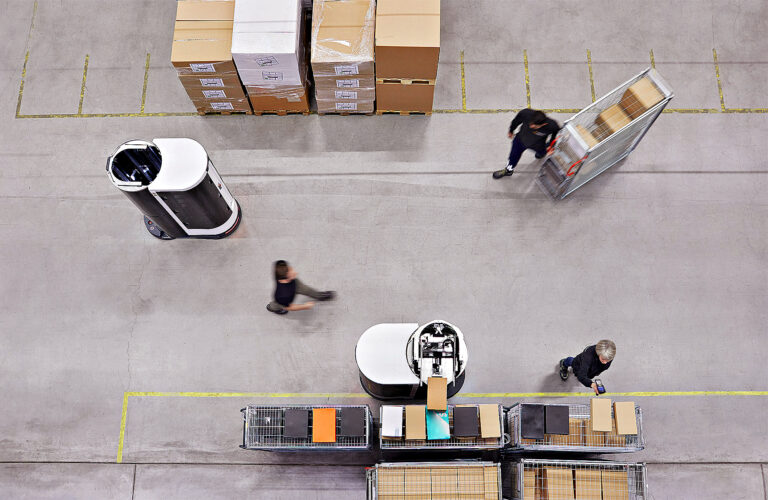Want to increase efficiency and speed and remove the risk of human error when it comes to processes in the warehouse? Then for years automated guided vehicles (AGVs) and now autonomous mobile robots (AMRs) have promised the answer.
Evolutions in automation are fundamental to shifts in the economy. Be it social distancing creating pressures on the way that warehouses are staffed – or the rise in e-commerce as the driving force of retail during a global pandemic, AGVs and AMRs are providing the backbone to such shifts.
Gavin Williams, managing director – supply chain, at XPO Logistics, tells Logistics Manager that the onset of Covid-19 and the response to the pandemic in the past three months has seen “five years of e-commerce growth in the space of five days!’
“There is a genuine new adopter using e-commerce,” he says of consumer buying habits during lockdown, “[and] there is obviously a definite swing to e-commerce and Covid-19 has accelerated it. It has become normal for people to use e-commerce, and I can see these trends being brought forward.”
For a 3PL like XPO Logistics, which has invested heavily in robotics and automation in its warehouses, using AMRs in particular to facilitate the industry shift is a “game-changer” for logistics in the medium to long-term.
“We are focusing heavily on AMRs – robots and cobots – and the reason we are doing that is it can have a significant benefit to accuracy; safety of employees; people engagement and efficiency. These are four good reasons – you are making your service more accurate; the environment you work in safer; the people that work in your environment are more engaged and you optimise and make more efficient the service you provide to our customer,” he says.
“What cobots really do is take out non value-added time. In a warehouse you will see people moving pallets in cages from stages in the warehouse, from goods-in to storage to pick to marshalling. What the cobots are doing is taking out the time where a person is accompanying that cage. Our enemy has to be dead time.”
Williams says that there are benefits for employees too, and recalls a meeting during a visit to one of its sites in Stoke-on-Trent, which is fitted with 6 River Systems collaborative robots: “I walked round with the warehouse picker and she said the speed to competence was significantly improved. The cobot is training as it goes along. She said she loved it and that is a language you don’t often hear in people’s jobs. She said the cobot was following her and she didn’t have to focus on pulling and pushing the cage. She could walk around, look up and be more social.”
 While efficiency and reliability might appeal from a financial point of view, particularly in the speed and volume world of e-commerce, improving employee wellbeing and safety is an additional benefit that is not often recognised.
While efficiency and reliability might appeal from a financial point of view, particularly in the speed and volume world of e-commerce, improving employee wellbeing and safety is an additional benefit that is not often recognised.
Supplement, not replace
Tony Dobson, SnapFulfil chief executive for UK & Europe, says it is a case of supplementing, rather than replacing, operatives plus making sure you’re adequately staffed during peak seasons and the likes of the current pandemic labour shortage. “Companies sometimes forget the contingencies they need to have in place in the event of a major and unprecedented disruption,” he says.
Kenny Watson, automation sales manager at Linde Materials Handling, says that AGVs can help to boost employee development and job satisfaction by performing many of the low value, repetitive and long-distance tasks that, until now, had to be performed by employees. “This gives employees more time to focus on the higher-level tasks that will enable them to become more skilled and develop professionally,” he says.
Replacing or supporting manual processes like picking is the low-hanging fruit for robotic-led automation, and many organisations are looking at the next-generation which shows the potential to improve and optimise more complex, integrated systems.
“More flexible layouts can enable improved material flow, better utilisation of space, and enhanced scalability , to name a few benefits,” says Kerstin Höfle, vice-president of portfolio and innovation management at Körber. “To design and realise such solutions, a high level of expertise in automation and warehouse design is required, because integrating a mobile robot into traditional automation equipment is not as easy. Starting with an efficient design of the overall material flow, challenges also lay in the handover process from mobile robots to traditional automation equipment, as for example conveying technology.

“In addition, a variety of new robotics suppliers are entering the market, so besides expertise in process automation, a thorough know-how about the technology itself and how to choose the right solution for the right processes is crucial. Despite these challenges, mobile and also other kinds of advanced robotics solutions will enter the warehouse automation industry and become the new standard,” she says.
Complexity not cost
Yet with complexity the concern will be cost, and this something that both customer and integrator will need to overcome. Linde’s Watson says AGVs can be installed to fulfil simple transport from one point to the other, by just pressing a button without the need for sophisticated software. But, he says, as with any technology, the more complex the system is the higher the investment will be.
“The average cost for purchasing an AGV system on a seven-year capital only lease works out at around £4 per hour. This means that the equivalent hourly rate of an automated truck on a longer-term lease can be significantly lower then the cost of a manual truck and operator. We would expect most businesses to see an ROI in an average of around 18 months, depending on factors such as the quantity of shifts worked and that business’s employment costs.”
Körber’s Höfle also says that while becoming more familiar with integrated layouts and the advanced robotics technology, it’s also of highest importance to keep an eye on a “transparent and holistic ROI calculation”. But, she says, calculating efficiency gains or the ROI of mobile robotics in an integrated system is not a simple task, as the entire solution has to be taken into consideration: “As one can easily compare manual operations against costs of workers being substituted by a robot, this is not the case for highly automated and integrated solutions -where the entire process and layout are affected. How can flexibility, or easy scalability be translated into savings?
“Besides these solvable challenges, there’s also a push towards new business models coming along with the rise of advanced robotics technologies. A variety of suppliers are already offering alternative business models like Robotics as a Service (RaaS), which are renting or leasing models. This is supporting the general trend in the industry for more flexible investments, meaning a shift from CAPEX to OPEX. Similar to the ROI calculation for more complex systems – this is not an easy to implement model. But, it’s a good point to start when exploring new business models, be it an evolution from rather product-based leasing or renting models, to a more and more performance-based approach.”
 However, Greg Downey, robotics specialist at OW Robotics, says that the cost factor is becoming less of a blocker for businesses of all sizes as technology continues to develop.
However, Greg Downey, robotics specialist at OW Robotics, says that the cost factor is becoming less of a blocker for businesses of all sizes as technology continues to develop.
“Now, the cost of either an AGV or an AMR is roughly the same, with a complete return on the investment usually achieved within a 18-36 month period. Once the initial implementation is covered, the price of robotics solutions are a lot cheaper than employing and training numerous extra employees to complete the same work, and your core warehouse employees can then focus on more specialist tasks, really utilising their skillsets,” he says.
Downy argues that the complexity factor is largely all smoke and mirrors, as installing the infrastructure is a lot easier than one might think.
“A robotics implementation team will come to your site and either 3D map your area for the AMR’s, or affix incredibly durable barcodes across your warehouse floor for the AGV’s,” he explains of the OW Robotics offering. “A central computer is then fully integrated with existing warehouse operation systems and feeds all the necessary instructions to the individual robot units wirelessly. The units can remain quite simple and easy to maintain and can be merely turned on before automatically linking with the computer hub for instructions.”
From our ongoing project data tracking, we estimate most projects’ ROI is between 18-36 months, with a range of other long term benefits quickly becoming obvious to those who turn to automated or robotic solutions says Kay Zhang, sales director at Hikrobot UK.
“Of course, it’s natural for clients to hesitate before making their final decision given that the implementation is likely to impact a number of processes throughout your business. With this in mind OWR has developed a strong after-sales service with the support of the Hikrobot software, which includes extensive training and maintenance – ensuring clients feel supported through the implementation journey and beyond.”
Using advanced AMR and AGV technology is changing the way that companies do business, says XPO’s Williams.
“We are influenced by the world around us, and the world around us wants products – especially in e-commerce – faster, cheaper, accurate and timely. What that means for logistics players like us is it puts the pressure on us to solve that problem faster and quicker, but the way to do that is to make it more certain. Technology will do that as it does what you ask it to do. It makes it more efficient. And when you put more volume into it, it becomes a cheaper option. In today’s world we are talking to customers about that sweet spot for using technology.”
This is how XPO is positioning itself in the market, particularly in e-commerce and retail: “We have an e-comm incubator solution,” explains Williams. “New players who do not know what their volumes will look like, we have a fast WMS we can deploy and can put them into a number of our shared user assets across the UK. The vast majority far outperform their forecast when they have gone live, so we move them from e-commerce incubator to a new, dedicated site – more likely manual – and we take our customers on a journey from manual to mechanised. Then we have the big names in e-comm that move from mechanised to automated.
“E-commerce incubator is how we win business in e-commerce,” he says. “We take them from manual to mechanised to automated and each one of those tipping points is volume driven and profile driven.”
 6 River Systems (Stand 602); Linde Materials Handling (Stand 512,610); OW Robotics (Stand 322) and SnapFulfil (Stand 320) will all be at IntraLogisteX 2020 – the UK’s only materials handling and intralogistics show this year – which takes place at the Ricoh Arena, Coventry on 1st and 2nd October. You can register now to attend!
6 River Systems (Stand 602); Linde Materials Handling (Stand 512,610); OW Robotics (Stand 322) and SnapFulfil (Stand 320) will all be at IntraLogisteX 2020 – the UK’s only materials handling and intralogistics show this year – which takes place at the Ricoh Arena, Coventry on 1st and 2nd October. You can register now to attend!







